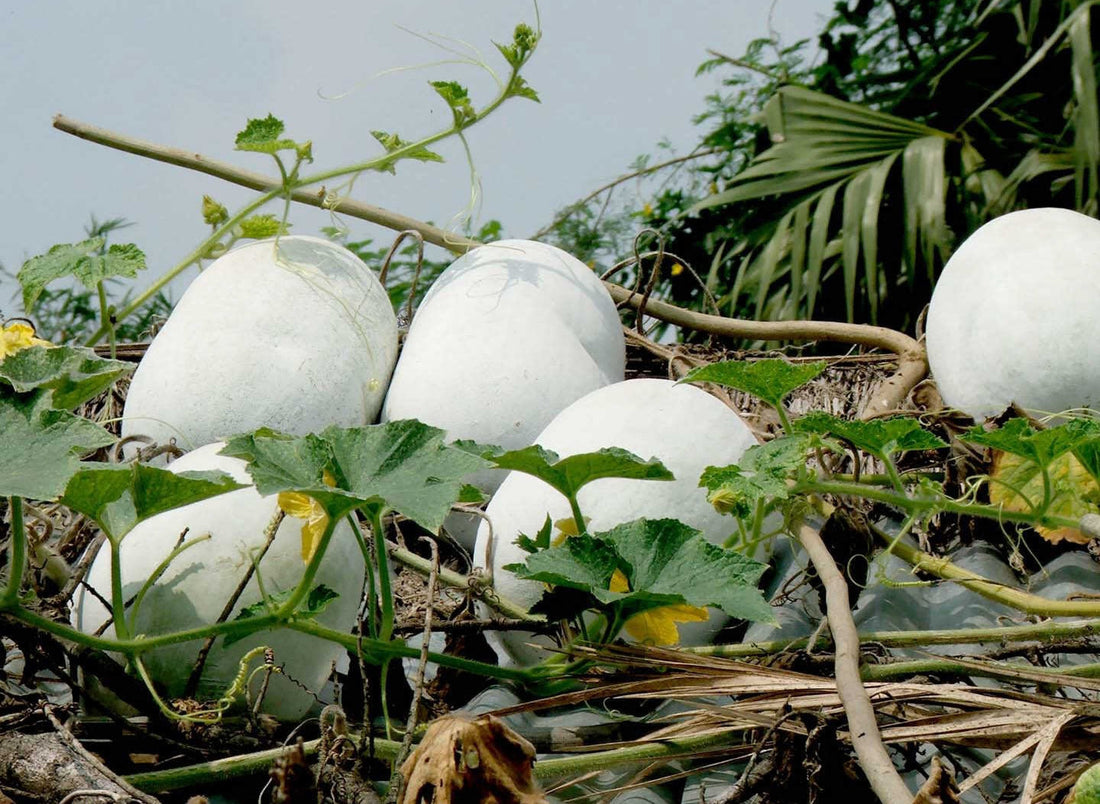
Grow Ash Gourd in Pakistan – Moji Mall Guide
Share
Growing ash gourd (پیٹھا / سفید کدو) at home is a rewarding experience, especially if you enjoy fresh, nutritious vegetables in your cooking. Ash gourd vines are strong, and with proper care, you can enjoy large, delicious fruits even in Pakistan’s warm climate. Here’s a simple guide to help you grow them easily at home.
| Aspect | Details |
|---|---|
| Best Sowing Time | February to April |
| Ideal Temperature | 20°C to 35°C |
| Germination Time | 7–10 days |
| Transplant Time | 2–3 weeks after sowing |
| Spacing | 3–4 feet between plants |
| Harvest Time | 100–120 days after sowing |
Step 1: Sow Seeds 🌱
When to Sow:
- Sow seeds from February to April once the danger of frost has passed.
- The ideal soil temperature for sowing is between 20°C and 35°C.
- Early sowing in warm soil gives strong vines and better fruit set.
How to Sow: Direct sow seeds into large pots or garden beds. Sow seeds 1 inch deep into loose, fertile soil rich in compost.
Germination Tips: Seeds sprout in 7–10 days under warm, moist conditions. Keep soil consistently moist during germination without making it soggy.
Step 2: Transplant Seedlings 🌿
When to Transplant: If starting in trays, transplant when seedlings have 2–3 true leaves, around 2–3 weeks after sowing.
How to Transplant: Use big containers like 20–24 inch pots or plant in garden beds with at least 3–4 feet spacing between plants to allow vines to spread freely.
Aftercare: Water well after transplanting. Provide support or a trellis if you want to save space and lift fruits off the ground.
Step 3: Care for Plants 🌞💧
Sunlight Needs: Grow ash gourd in full sun, with at least 6–8 hours of direct sunlight daily for strong vine growth.
Watering: Water deeply 2–3 times a week, keeping the soil evenly moist. Increase watering during flowering and fruiting stages.
Feeding Schedule: Start feeding after 3 weeks with balanced fertilizer (NPK 20-20-20) every 15 days. Once fruits set, switch to NPK 5-15-45 to encourage healthy, large fruit development.
Step 4: Protect Plants 🐛
Common Pests: Look out for aphids, fruit flies, and leaf beetles.
Natural Protection: Spray neem oil every 10–12 days (1 teaspoon neem oil + 1 liter water + few drops soap) to control pests naturally.
Common Problems:
- Poor Fruit Set: Caused by lack of pollination — hand-pollinate flowers early in the morning if bees are scarce.
- Fruit Rot: Happens if fruits touch wet soil — use straw mulch or lift fruits off the ground.
- Powdery Mildew: Appears in humid conditions — ensure good air circulation and avoid wetting leaves unnecessarily.
Step 5: Harvest Fruits 🎯
When to Harvest: Ash gourd is ready to harvest 100–120 days after sowing, when fruits turn pale, develop a white waxy coating, and sound hollow when tapped.
How to Harvest: Cut the fruit using a sharp knife, leaving a short piece of the stem attached for longer storage.
Bonus Tip: Handle fruits carefully to avoid damaging the waxy skin, which protects them and helps them store longer.
FAQs
1. Can I grow ash gourd in pots?
Yes, but use very large pots (at least 20–24 inches wide and deep) and provide strong trellis support if space is limited.
2. Why are my ash gourd flowers falling without fruits?
Male flowers appear first and fall naturally. Fruit forms after successful pollination of female flowers, which usually appear slightly later.
3. How often should I water ash gourd plants?
Water deeply 2–3 times a week and adjust frequency depending on weather and soil dryness, especially during fruiting.
4. How long can harvested ash gourds be stored?
If properly harvested and stored in a cool, dry place, ash gourds can last for 2–3 months thanks to their natural waxy skin.
Growing ash gourd at home is about giving the vines space, sun, and steady care. With patience and proper watering, you’ll soon enjoy your own harvest of big, healthy fruits — perfect for summer dishes and traditional recipes.

